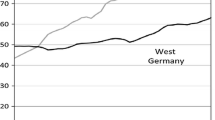Abstract
Individual-level retrospective data from the Family and Occupation Survey of 1988 are used to estimate the effects of various employment variables on the third-birth rates among post-war Norwegian birth cohorts. Women who appear to have a strong work orientation, and may face relatively high opportunity costs of childbearing, do not have particularly low probability of advancing to parity three. This is consistent with previous Swedish and British studies, and lends some support to the view that other factors than stronger employment preferences and increased job opportunities have been largely responsible for the “second demographic transition” in Europe.
Résumé
On utilise ici des données rétrospectives individuelles, issues de l'enquête sur la Famille et la Profession de 1988, pour estimer les effets de diverses variables concernant l'emploi sur les taux de fécondité de rang trois de cohortes norvégiennes nées après la guerre. Les femmes qui semblent avoir une forte orientation vers la vie active, et qui peuvent faire face à des coûts relativement élevés pour leurs enfants, n'ont pas une probabilité particulièrement basse d'avoir un troisième enfant. Ce résultat est en accord avec des études suédoises et anglaises antérieures, et donne quelque appui à la thèse selon laquelle d'autres facteurs qu'un attrait plus fort vers la vie active et des offres d'emploi croissantes, ont été la cause principale de la “seconde transition démographique” en Europe.
Similar content being viewed by others
References
Becker, G.S., 1960. An economic analysis of fertility. In: National Bureau of Economic Research, eds. Demographic and Economic Changes in Developed Countries. Princeton University Press, Princeton, NJ.
Bernhardt, E.M., 1972. Fertility and economic status—some recent findings on differentials in Sweden. Population Studies, 26: 175–184.
Bernhardt, E.M., 1989. Fertility and employment. Stockholm Research Reports in Demography 55, Stockholm University.
Bernhardt, E.M., 1991. Working parents in Sweden: an example for Europe. Prepared for the Eurostat Conference on Human Resources at the Dawn of the 21st Century, Luxembourg, 1991.
Brunborg, H., 1984. An economic model of fertility, sex and contraception. SØS 56, Central Bureau of Statistics, Oslo-Kongsvinger.
Central Bureau of Statistics, 1991. Family and Occupation Survey 1988. NOS B 959, Oslo-Kongsvinger.
Cramer, J.C., 1980. Fertility and female employment: problems of causal direction. American Sociological Review, 45 (2): 167–190.
Ellingsæter, A.L., 1991. Hvorfor jobber pappa overtid? Om årsaker til, og konsekvenser av fedres lange arbeidstid. In: R. Haukaa, ed. Nye menn, nye kvinner. Ad Notam, Olso.
Freedman, D.A. and Thornton, A., 1982. Income and fertility: the elusive relationship. Demography, 19 (1): 65–78.
Heckman, J.J. and Walker, J.R., 1990. The third birth in Sweden. Journal of Population Economics, 3: 235–275.
Hoem, B. and Hoem, J.M., 1989. The impact of female employment on second and third births in modern Sweden. Population Studies, 43 (1): 47–67.
Hoem, B., 1990. Alla goda ting är tre? Tredjebarnsfödslar bland svenska kvinnor födda 1936–50. Stockholm Research Reports in Demography 59, Stockholm University.
Jones, E., 1981. The impact of women's employment on marital fertility in the US, 1970–75. Population Studies, 35: 161–173.
Klijzing, E., Siegers, J., Keilman, N. and Groot, L., 1988. Static versus dynamic interaction between female labour force participation and fertility. European Journal of Population, 4: 97–116.
Kravdal, Ø., 1991a. Hvor mange barn? University Press, Oslo.
Kravdal, Ø., 1991b. Reproductive behaviour in Norway 1960–1990: the impact of economic changes and reforms. Presented at the ESF Working Party on Family Trends in Europe, Stockholm, December 1990.
Kravdal, Ø., 1992. The emergence of a positive relation between education and third-birth rates in Norway with supportive evidence from the United States. To appear in Population Studies, 46(3).
Lesthaeghe, R. and Meekers, D., 1986. Value change and the dimension of familism in the European community. European Journal of Population, 2: 225–268.
Mott, F.L. and Shapiro, D., 1983. Complementarity of work and fertility among young American mothers. Population Studies, 37: 239–252.
Ní Bhrolcháin, M., 1986. Women's paid work and the timing of births: longitudinal evidence. European Journal of Population, 2: 43–70.
Ryder, N.B., 1979. The future of American fertility. Social Problems, 26 (3): 359–369.
Simon, J.L., 1975. The mixed effects of income upon successive births may explain the convergence phenomenon. Population Studies, 29 (1): 109–122.
Ware, H., 1976. Fertility and work-force participation: the experience of Melbourne wives. Population Studies, 30: 413–427.
Willis, R.J., 1973. A new approach to the economic theory of fertility behaviour. Journal of Political Economy, March/April supplement.
Wineberg, H. and McCarthy, J., 1989. Child spacing in the United States: recent trends and differentials. Journal of Marriage and the Family, 51: 213–228.
Wright, R.E., Ermisch, J.F., Hinde, P.R.A. and Joshi, H.E., 1988. The third birth in Great Britain. Journal of Biosocial Science, 20 (4): 489–496.
Author information
Authors and Affiliations
Rights and permissions
About this article
Cite this article
Kravdal, Ø. The weak impact of female labour force participation on Norwegian third-birth rates. Eur J Population 8, 247–263 (1992). https://doi.org/10.1007/BF01797212
Received:
Revised:
Issue Date:
DOI: https://doi.org/10.1007/BF01797212




